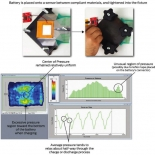From electronic devices to high-efficiency vehicles, consumer demand continues to grow for more compact, lightweight, quick-charging battery technologies with higher energy densities. At the same time, batteries should also be safe, even in catastrophic events. Lithium-ion (Li-ion) has become a favorite battery technology among engineers and designers because it satisfies many of these demands, and is cost-efficient. As battery designers continue to push the limits of Li-ion battery capabilities, however, many of these requirements can conflict with one another.
Recently, battery designers have turned to pressure mapping systems to collect comprehensive data during Li-ion battery testing. The thin and flexible array of sensing elements can wrap around the battery to provide a 360° view within a testing fixture. These systems can be used to evaluate pressure profiles over thousands of charge and discharge cycles, which can last several months.
This Tech Briefs article gives a glimpse into how Tekscan force & pressure sensors are helping improve the safety and longevity of this popular power source.
